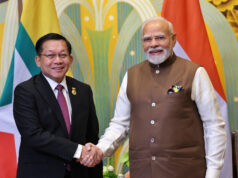Daesh-Khorasan (Daesh-K), once seen as a regional offshoot of the Islamic State operating within the Afghanistan-Pakistan corridor, has morphed into a transnational threat with strategic designs on South Asia, Central Asia, and Europe.
Its capacity to recruit across borders, exploit local grievances, and deploy propaganda in multiple languages places India and the surrounding region in a critical position in this evolving security landscape.
The SAWAB Center’s June 2025 study underscores how Daesh-K has grown into one of the most dynamic wilayas (provinces) of the Islamic State.
Formally established in 2015 with the blessing of Daesh Central, its current leader, Shahab Al Muhajir—also known as Sanaullah Ghafari—has expanded the group’s operational independence and enhanced its international outreach. He is listed by the UN Security Council for financing and planning acts of terrorism, and his leadership marks a turning point in Daesh-K’s ability to operate beyond traditional boundaries.
Daesh-K’s rise is tied closely to political vacuums in Afghanistan, fractured governance, and the ideological disillusionment of defectors from both the Taliban and Al Qaeda. India, already a repeated target in the group’s rhetoric and propaganda, is named in the report as one of the countries where Daesh-K-linked plots were reportedly thwarted in 2023 and 2024. While the exact details of those foiled attacks are not provided, India’s inclusion in this list places it squarely within the group’s expanding field of interest.
The group’s strategy revolves around exploiting regional grievances, targeting disenfranchised youth, and radicalising individuals through tailored messaging. In South Asia, Daesh-K’s propaganda makes strategic use of emotional and ideological narratives. Voice of Khorasan—its multilingual flagship magazine—routinely attacks the Indian government and security forces, framing the Kashmir conflict as a religious occupation. Issue 39 of the magazine, for example, featured an article titled “Kashmir, the Paradise under the control of Infidels,” blending regional grievances with transnational jihadist narratives.
What makes the Daesh-K threat more acute for India is the group’s demonstrated ability to radicalize beyond physical borders. Many Central Asians linked to Daesh-K were reportedly recruited while working abroad in vulnerable, low-income environments—especially in Russia. The same recruitment logic could extend to South Asian migrant communities, particularly from India, Pakistan, and Bangladesh, who face socio-economic alienation in the Gulf and parts of Southeast Asia.
India’s linguistic diversity and its sizeable Muslim population have not gone unnoticed by Daesh-K propagandists. The group has produced materials in Urdu, Hindi, Malayalam, and other South Asian languages, thereby targeting a wide range of demographics. While India has significantly tightened its counter-radicalisation mechanisms, especially online, the SAWAB report warns that Daesh-K has adapted rapidly to platform bans by migrating to encrypted apps like Telegram and Rocket.Chat. These tools enable the dissemination of propaganda and the coordination of recruitment without detection.
Another area of concern is Daesh-K’s persistent targeting of regional adversaries in its propaganda—India among them. Alongside the Taliban, Iran, and Pakistan, India is depicted as a regional oppressor in Daesh-K’s narratives. These portrayals serve to rally support across various geographies and to justify future attacks. In this sense, India is not merely collateral damage in Daesh-K’s global jihad—it is one of its ideological enemies.
The group’s recent attacks and foiled plots across Eurasia demonstrate both its ambition and its capabilities. While Europe is seen as a high-value target due to symbolic significance and ease of infiltration through migrant routes, South Asia represents an ideological battleground with deep historical and political roots. The group’s criticism of nationalist struggles, including Hamas and the Taliban, indicates its disdain for what it sees as politically compromised Islamist movements. This raises concerns about Daesh-K’s potential to attract more radicalised individuals in South Asia who are disillusioned with existing religious or political groups.
India must also pay attention to Daesh-K’s recruitment of youth and women. The group’s propaganda includes memes, videos, and gamified content designed to resonate with younger audiences. Recent issues of Voice of Khorasan have also shifted in tone toward women, blending traditional gender roles with newer narratives of female leadership and operational readiness. This evolving communication strategy increases the risk of homegrown radicalisation among young men and women alike in South Asia.
The group’s operational doctrine, as outlined by its leader in the 2023 book Islamic Political System, advocates attacks in cities with high security to intimidate adversaries. Such guidance, the report warns, could influence lone-actor or hybrid attacks in dense urban areas of South Asia, including India. While the Crocus City Hall attack in Moscow is cited as a model for such action, similar scenarios targeting high-profile Indian events, religious gatherings, or urban infrastructure cannot be discounted.
India’s multi-layered social fabric, combined with existing communal tensions, could provide fertile ground for radicalisation if not proactively addressed. The SAWAB report repeatedly stresses that effective counterterrorism responses must go beyond security surveillance and include community engagement, socio-economic support, and tailored counter-narratives. This is particularly important in India’s context, where aggressive policing or stigmatisation of certain communities could inadvertently aid extremist recruitment.
The report also outlines efforts by Central Asian governments to combat radicalisation through education and soft-power initiatives. Uzbekistan’s Imam Bukhari Center is highlighted as a model of promoting religious pluralism to counter extremist narratives. Similar models may hold relevance for India, especially in states where Salafist or Wahhabi influences are more pronounced.
Daesh-Khorasan poses a clear and present threat to South Asia, and India in particular, which is highlighted by the group’s rhetoric, attempted attacks, and tailored recruitment strategies. It is a borderless insurgency feeding on alienation, identity politics, and ideological disillusionment. The battle against it will require not just a counterterrorism force but a long-term, culturally literate, and socially inclusive strategy.
India, given its geopolitical and demographic profile, cannot afford to underestimate this growing menace.
In a career spanning three decades and counting, Ramananda (Ram to his friends) has been the foreign editor of The Telegraph, Outlook Magazine and the New Indian Express. He helped set up rediff.com’s editorial operations in San Jose and New York, helmed sify.com, and was the founder editor of India.com.
His work has featured in national and international publications like the Al Jazeera Centre for Studies, Global Times and Ashahi Shimbun. But his one constant over all these years, he says, has been the attempt to understand rising India’s place in the world.
He can rustle up a mean salad, his oil-less pepper chicken is to die for, and all it takes is some beer and rhythm and blues to rock his soul.
Talk to him about foreign and strategic affairs, media, South Asia, China, and of course India.





